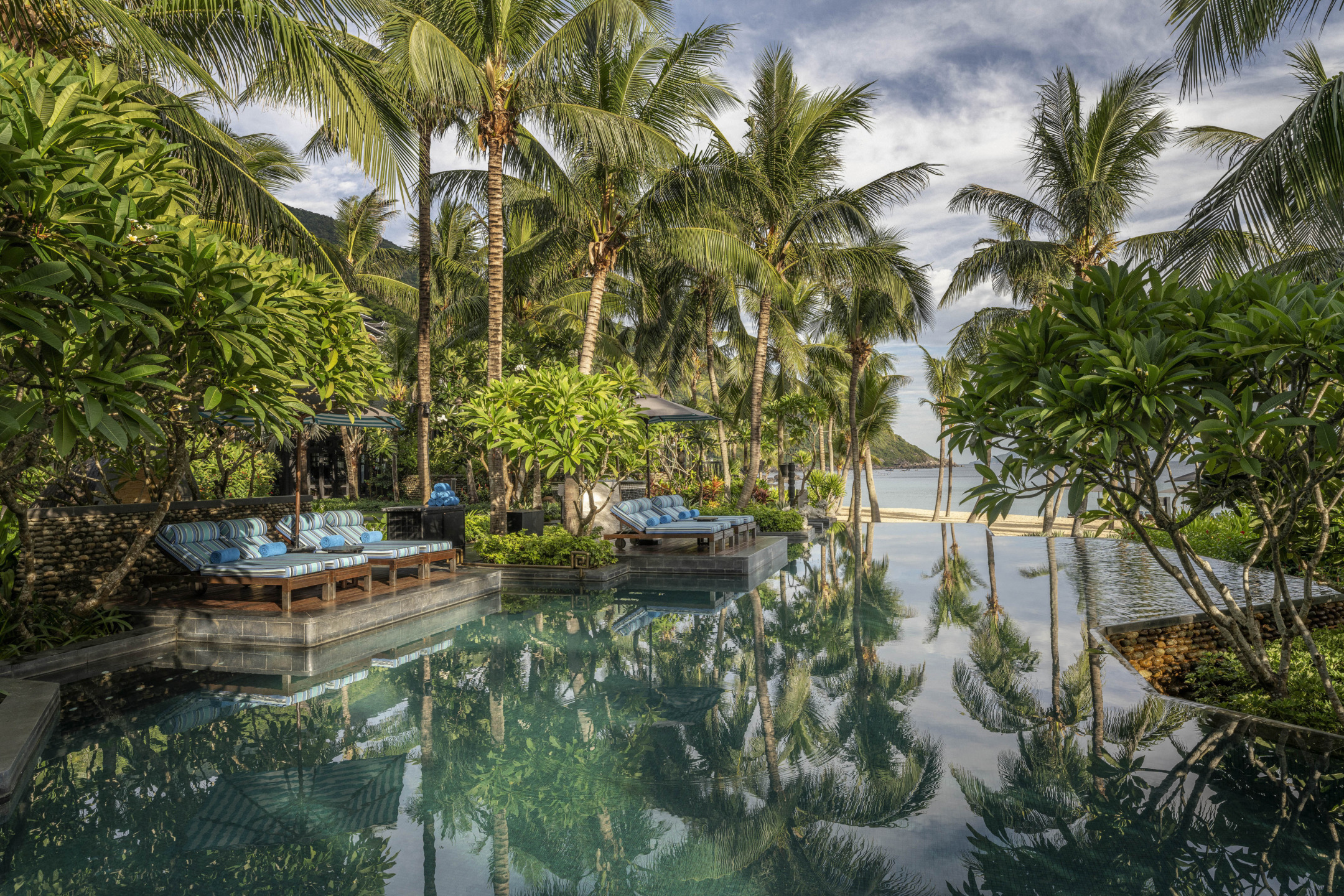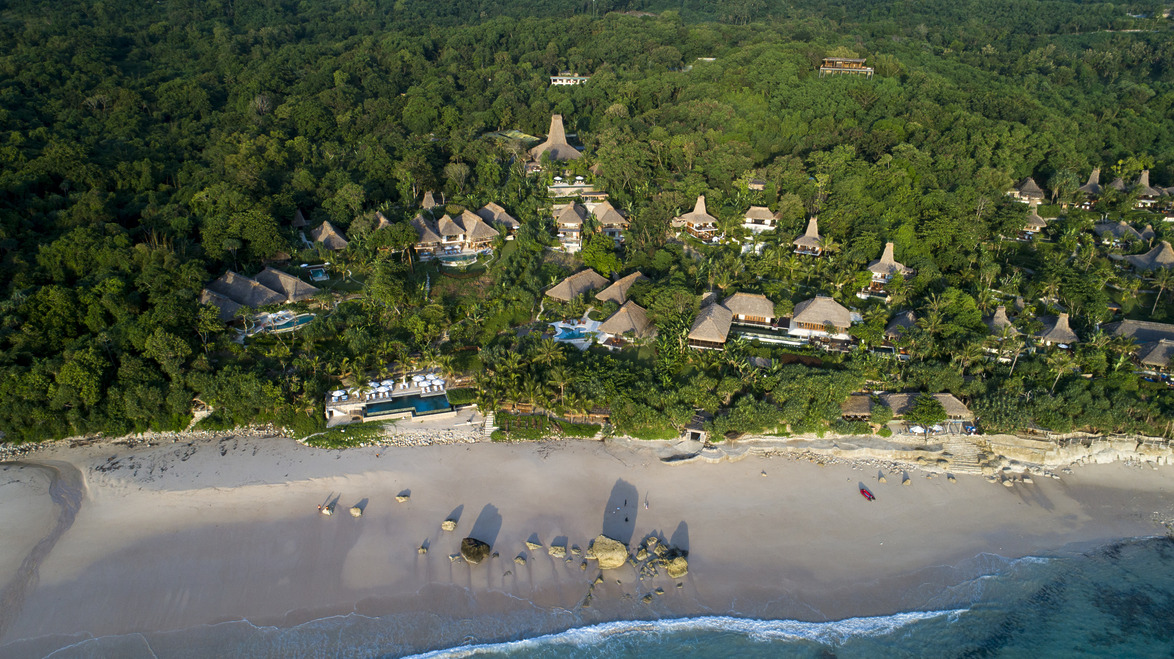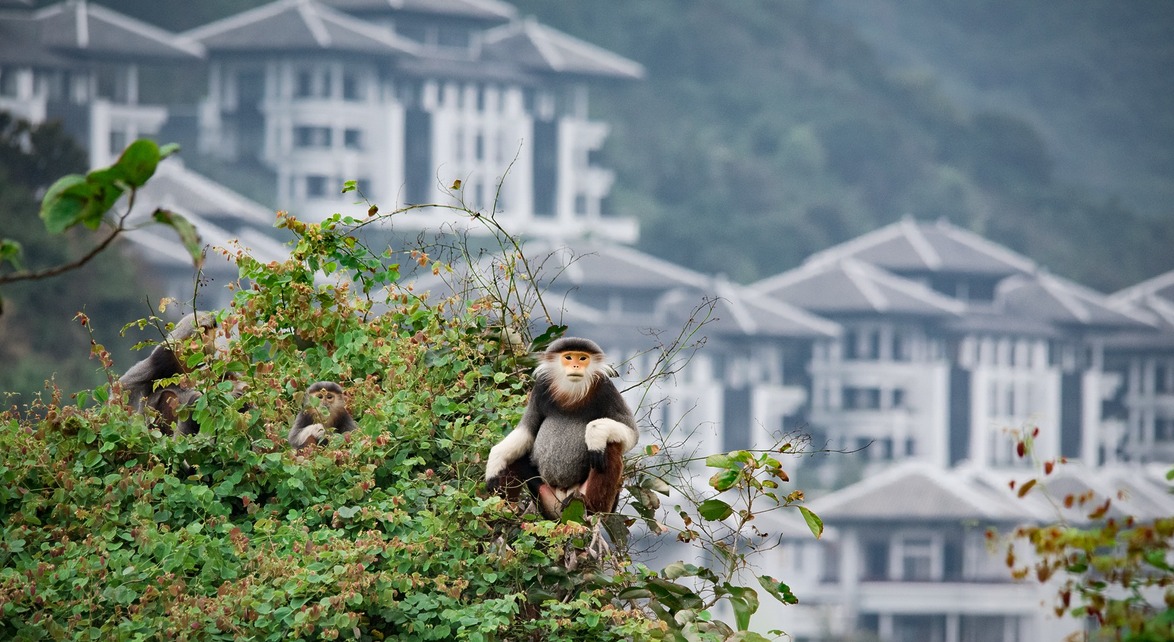Where to Get Your White Lotus Fix Beyond Thailand
These luxury resorts across Southeast Asia all offer tropical oceanfront settings, private villas, and five-star service—but without the current hype

Season three of HBO’s hit series The White Lotus brought the satirical drama about wealthy vacationers to Thailand, and with it, an all-but-certain influx of visitors hoping to experience their own slice of tropical luxury.
The show’s third outing was primarily filmed on Koh Samui, at the Four Seasons Resort as well as Anantara’s Lawana and Bophut resorts on the island, and its Mai Khao Villas in Phuket. If season two’s sojourn to Sicily is anything to go by, travel experts are predicting a huge uptick in vacations to Thailand following the show’s finale earlier this spring. The country’s reputation for breathtaking white sand beaches, fragrant cuisine, rich culture, and warm, welcoming people have drawn international visitors in increasing numbers for years—first boosted by the 2000s cult movie The Beach, then hampered by the devastating tsunami of 2004, before recovering again relatively quickly. But the renewed White Lotus-fueled demand is likely to limit vacancies, pack restaurants, and drive-up flight costs and room rates more than ever.
Luckily, Southeast Asia is a large and richly diverse region, and its nations have hundreds of miles of stunning coastlines that are peppered with luxury accommodation options—not to mention some of the world’s best food and most welcoming communities. For those jetsetters looking for White Lotus vibes but without the inevitable crowds, Galerie has curated a list of similar five-star, villa-style resorts with lush rainforest settings, beach access, wellness offerings, and historic cultural sites in close proximity. Just watch out for the monkeys!
1. Indonesia
Across the vast archipelago of Indonesia, the best geared towards travelers is Bali due to its developed infrastructure (though sometimes stifling traffic) and wealth of accommodation options. While partygoers head to the towns of Kuta and Seminyak, many of the island’s luxury beach resorts are clustered around Nusa Dua on its southernmost peninsula.
Among these is The Ritz-Carlton, Bali, a stunning cliffside property encompassing five dining venues, a marine-inspired spa, and a striking beachfront chapel. The best suites are the ground-level villas, with private pools immersed in greenery, and the Sky Villas that enjoy lofty views over the resort to the ocean. New for this season is a collaboration with Missoni, which includes a boutique stocked with the Italian fashion brand’s signature zig-zag striped apparel and accessories, and a takeover of the beach club. Umbrellas and loungers have been swapped for custom-striped designs, and the restaurant menu integrates Italian favorites into its seafood-forward menu, while cocktails receive a (literal) brand infusion with potables made using Missoni x Malfy Gin.
More remote, touching the black sands along Bali’s southwestern coast, Soori Bali is surrounded by vivid green terraced rice fields, and designed in a highly contemporary but still contextually sympathetic architectural style. Crafted by SCDA Architects, the 48 villas feature private pools with sweeping vistas of either mountain or ocean, and the communal areas encompass a full-service spa, infinity pool, bar, conference room, 24-hour gym, and library. The two restaurants, Cotta and Ombak, both use fresh produce from nearby farms and spices from the property’s own garden, and the concierge specializes in experiences that connect guests with Balinese culture and customs.
Meanwhile, the Amankila resort on the other side of the island sits on the lower slope of Mount Agung, where the lush hillside meets the Lombok Strait. Connected by frangipani-lined walkways through the treetops, 31 stilted suites are decorated with inlaid pearl and coconut shell furniture and feature canopied beds. A three-tier infinity pool at the property’s center cascades down towards the Beach Club, which leads to a private black-sand beach.

For something a little more off-the-beaten path than Bali, the island of Sumba hides a special resort that was named to the World’s 50 Best Hotels list for 2024. NIHI Sumba is a true wilderness escape, and retains much of its original rustic surf-shack charm while offering a refined guest experience. There’s 28 uniquely designed, thatched-roofed villas and estates of various shapes and sizes, so guests can choose their preference. For the active, there’s horse riding on the beach and world-class surfing, while those wanting to unwind can choose from jungle yoga, underwater meditation, or the resort’s signature Spa Safari.
2. Vietnam

Vietnam has been an up-and-coming destination for U.S. travelers for some time now, and while its popularity is growing, there are still notably fewer tourists here than in Thailand. The country is blessed with a long, snaking coastline glittered with glorious beaches, and some of the best are located in its central section—quite far removed from the main international transit hubs of Hanoi in the north, and Ho Chi Minh in the south. A short, connecting internal flight will get you to Danang, around which several high-end resorts are located.
On a peninsula known as “Monkey Mountain” outside the city sits the InterContinental Danang. If it looks slightly familiar, it might be because the resort was designed by Bill Bensley, the same architect as the Four Seasons Koh Samui. Four main levels—Heaven, Sky, Earth and Sea—are connected by a basket-shaped funicular railway and cascade down to a private sandy bay. Pitched-roof volumes staggered up the steep hillside are based on ancient Vietnamese temples, and include the three-bedroom Sun Peninsula residences decorated in a bold black and white palette with zesty accents.
In nearby Hoi An—a historic port city of colonial buildings that’s designated as a UNESCO World Heritage Site—is The Nam Hai, a Four Seasons property. It occupies a huge swath of beachside real estate and comprises 100 villas that can accommodate most group sizes, and either face the sea or the jungle. A cooking academy allows guests to master the flavors of Vietnam’s famed street food, and guided tours are available for exploring Hoi An, the nearby former imperial city of Hue, and other local sites and landmarks.
Meanwhile, closer to the city of Nha Trang (which also has a regional airport), remote getaways include Amanoi, an Aman property set within the wilderness of Núi Chúa National Park and boasting a private beach, a clifftop pool, and a lakeside spa. The property has just introduced a new three-bedroom residence designed for families and groups featuring the expansive interiors that seamlessly open onto a panoramic sundeck. An alfresco dining area, two swimming pools, and direct access to a private beach allow guests to make the most of time outdoors.
Similarly, the Six Senses Ninh Van Bay lines its own cove, and is both perched upon and cut into the rocky landscape. The resort has 62 generously sized villas, each with its own private pool and either open-plan layouts or separate living spaces. The three-bedroom Rock Retreat on the western tip and larger Water Reserve are both accessed via a private speedboat, or a walkway for those willing and able to make the trek, as well as waterslides into their plunge pools. Tailored Six Senses wellness programs incorporate traditional Vietnamese treatments, while rock climbing, catamaran sailing, and cooking classes are all available.
3. Malaysia
Malaysia is split across the island of Borneo, and the Malay Peninsula south of Thailand where most visitors tend to find themselves. The country’s version of Koh Samui or Phuket is Langkawi, off the peninsula’s northwest coast, where many luxury hospitality brands have properties. These are situated at different ends of the island, which helpfully has its own international airport.
The Ritz-Carlton Langkawi’s architecture is based on local vernacular, with Asian restaurant Langkawi Kitchen influenced by the longhouses of indigenous Bornean tribes, and The Beach Grill beside the main pool comprising four conical structures inspired by the Malay “Bubu” fish traps traditionally woven from bamboo and rattan. Spa treatment rooms are similarly housed in a series of cocoon-shaped pods perched on the rocks overlooking the ocean, while a variety of waterfront and rainforest villas range from one to three bedrooms and each come with a private pool.
Located within a sanctuary for several tropical bird species, including hornbills, the Four Seasons Resort Langkawi occupies a mile-long sandy beach and towering limestone cliffs. The setting includes mangrove forests, winding rivers, and ancient sea stacks—perfect for nature lovers hoping to explore. In the guest rooms, carved millwork is based on traditional Malay craftsmanship, and décor includes Moorish details and local touches. The resort’s newly redesigned five-bedroom villa comfortably sleeps eight, and features two private beachfront pools in which to soak up the Andaman Sea views.
Also well worth considering is The Datai, an independent hotel that’s nestled into a remote mountainside on Langkawi’s northwest corner. Its 121 rooms, suites and villas are immersed in tropical flora and have access to a rainforest spa, a golf course, and a beach that wraps around a turquoise bay facing the Andaman Sea. Dining options vary from the award-winning Pavilion, perched on 30-meter stilts among the treetops, to the casual Beach Club and Bar along the shore—as well as several others in between.
4. Cambodia
Best known and most commonly visited for its vast temple complexes like the magnificent Angkor Wat, Cambodia also boasts a gorgeous coastline of small islands that aren’t yet on most U.S. tourists’ radar. While a visit to Cambodia from the States requires lengthy travel times, the tranquillity and authenticity of this relatively undeveloped corner of Southeast Asia makes it well worth the journey—and a perfect wind-down after exploring the historic sites.
A favorite amongst international travelers is Song Saa Private Island, which comprises a collection of over-water villas like those typically found in the Indian Ocean archipelagos or Pacific atolls. The resort is deeply tied to nature and operates a foundation dedicated to preserving the Koh Rong Marine National Park, in which it sits. The Vista Bar and Restaurant serves locally caught seafood, seasonal fruit and vegetables, and freshly baked breads—all prepared in a Cambodian style. Oversized bean bags are provided for enjoying pre- or post-dinner drinks overlooking the water.
Also on its own island, just a 10-minute drive from Sihanouk International Airport followed by a 15-minute water transfer, Six Senses Krabey Island provides an intimate and ultra-private experience. Forty private free-standing pool villas have secluded sun decks and sustainably designed green roofs, while a spa at the top of the island offers traditional Khmer massage and Cambodian healing treatments. The main lobby, lounge, and sunset bar are designed to resemble a traditional fisherman’s house, and each of the four dining options benefit from sea views. Activities include complimentary water sports, boat excursions to surrounding islands, and movies played on a big screen under the stars.
5. Singapore
One of the region’s main transit hubs and financial centers, Singapore also offers visitors the opportunity to relax and unwind on Sentosa Island—a leisure and recreation destination with beaches, golf courses, theme and water parks, and more, located only a 15-minute drive from the Central Business District.
Five-star options on the island include Capella Singapore, which is arranged around two restored Tanah Merah colonial bungalows dating back to the 1880s from which the hotel’s gardens and grounds extend. These manors, reimagined by Matthew Shang Design Office, form the hotel’s top accommodation category alongside the Capella and Contemporary Manors along the estate’s periphery. The resort’s main building, designed by Foster + Partners, traces a curved, continuous shape and is defined by its red roof. This houses Cantonese restaurant Cassia, Bob’s Bar for sunset cocktails, and newly opened Italian eatery Fiamma, amongst other guest amenities.
The newly opened Raffles Sentosa extends the luxury of the famed, historic Raffles Hotel in downtown Singapore to the relaxed resort island. In March, this all-villa property right next to the Capella began welcoming guests to the Yabu Pushelberg-designed spaces filled with natural materials, and featuring floor-to-ceiling windows that frame views of the verdant landscaping. Five dining destinations allow guests to sample a range of global cuisines, and the spa is located in a transformed heritage building.
6. Philippines
Another sprawling archipelago of paradise islands surrounded by turquoise waters, the Philippines is also slowly becoming a more popular destination but currently remains largely unspoiled. The country’s clusters of islands are grouped into regions, each offering a slightly different take on a tropical landscape and its own cultural idiosyncrasies.
In Palawan, the Aman group has infused its signature minimalist style with Filipino design at Amanpulo, which occupies its own island accessible only by a private airstrip. This secluded island hideaway is ringed by dazzling white sand where several species of sea turtle nest, and a coral reef that guests can explore with help from the resort’s dedicated dive center. Villas and casitas designed by Filipino architect Francisco Mañosa are dotted amongst the jungle, while numerous dining and drinking options include the Clubhouse serving Southeast Asian fare and a cigar selection, plus a floating bamboo bar that can be reserved for picnics or cocktails.
Located on the country’s best-known party island, Shangri-La Boracay is tucked in a sheltered bay that’s far enough removed to still feel secluded, but close enough to still be a part of the action. Of the 219 guest rooms and villas, the Presidential Villa is the premium offering—composed of three separate thatched structures set within elegant grounds that include a sunset viewing deck. Meanwhile, the Loft Garden Villas are each tucked away in landscaped tropical landscapes and consist of an upstairs luxury bedroom and a downstairs living area that connects to a private infinity pool, an outdoor shower, and pergolas for alfresco dining.


































